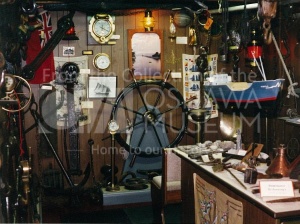By Melissa Cole, Curator
The Oshawa Museum has a unique collection of artefacts that were recovered from Lake Ontario by Robert Stephenson, an amateur shipwreck researcher and Lake Ontario diver. While in the RCAF in England during the Second World War, Mr. Stephenson did some experimental diving as a hobby. Ship wreck material were not the only items he recovered from Lake Ontario shoreline around Oshawa/Whitby; he discovered rifles, safes, cars and the Hon. Gordon D. Conant Plaque that had been stolen in August 1966 from Lakeview Park. He found it a week later in 26 feet of water in the Oshawa Harbour.

Robert Stephenson lived in Oshawa on Stone Street where he had a small museum that he called The Sea Shanty Museum. This is where he showcased the many treasures (ship wreck material) that he discovered along the shores of Lake Ontario in Oshawa. Once he decided to close his Sea Shanty Museum – the artefacts were donated to the Oshawa Museum and the Bruce County Museum & Archives in Southampton, Ontario.

On the evening of September 20, 1921, an era of nautical history abruptly came to an end when the schooner Helen ran aground off McLaughlin Point. The Helen began her life some 51 years earlier as the tow barge, J.J. Pugsley. At 70 feet long, 30 feet wide and sporting two masts, the Helen hardly appeared revolutionary.
However, a close inspection would reveal that she was the first Great Lakes schooner to be fitted with an auxiliary combustion engine — an innovation that, according to one marine historian, “was as far in the future as the flying machine.”
As futuristic as the Helen may have been, she spent the vast majority of her years as a stone-hooker. This is a type of schooner specifically designed to lift stones from the lake bed and transport them to shore where they would be used in the construction of new harbours, docks, and roadways. From 1850- 1900, it was not uncommon for entire fleets of stone-hookers to be operating on Lake Ontario.
Of hundreds built, only one stone-hooker, the Helen remained in service past 1920. Soon however, the fateful day would come for the Helen. On September 20, 1921, she was heading home to Bond Head, Newcastle with a full load of stones when a strong gale forced her to crash against a large rock off McLaughlin Point (which had been named “Oshawa Island”).
Captain Goldring, who was alone aboard the ship, managed to escape before his command of 49 years sunk beneath the murky depths. The Helen was the third ship to meet her demise on Oshawa Island that year.

The rotting hull of the Helen lay undisturbed and forgotten until 1964 when Robert Stephenson set out to locate the famous schooner. When diving in this area around this large rock, Mr. Stephenson could sit and rest on this boulder with all his upper body out of the water.
At the base of the boulder, bits and pieces of marine hardware were found, as well as parts of present day motorboats and fittings from old steam vessels. A long trail of heavy items was located by Bob, leading into deeper water in a south westerly direction. There were splicing thimbles, iron spikes, stud-link chain, and one piece of iron on which was an encouraging message…the word “SUCCESS.”
Years passed and Mr. Stephenson had spent over 200 hours underwater searching. Finally one day, a length of wire was located on the bottom, again leading to the south west. It crossed a channel that was 10 feet wide and about 6 feet deep. Wallowing under 3 feet of algae Bob found a small “Belaying pin,” a wooden “Sheave,” several large unidentified fittings and finally a wire led through a collection of “mast hoops” and other rigging parts to the edge of a 20 foot drop. Peering through the dark water below was a number of massive timbers pointing up through the green gloom. It was the HELEN!!!!
In 2014, Visitor Host Shawn wrote about Helen’s steering wheel, his favourite artefact, in celebration of our exhibit, IT’Story.


